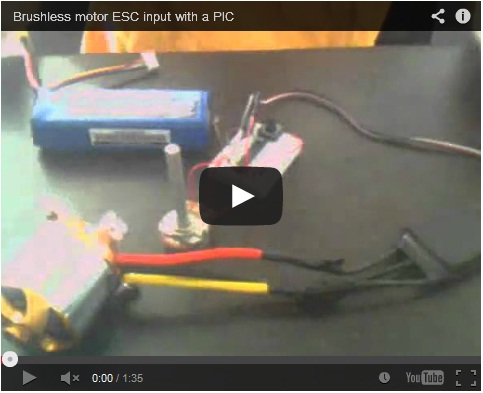(
http://lordvon64.blogspot.com/2011/0...-pwm-with.html)
Easy pulse width modulation (PWM) with PICs to control brushless motor ESCs, servos, and other things
Today I present a brushless motor controlled by an electronic speed controller (ESC) and a PIC microcontroller. The PIC microcontroller performs the function of a R/C reciever by taking in a signal (here generated by a pot) and outputting the appropriate signal (here a PWM square wave) for the ESC to use to determine the rotation speed of the brushless motor

Simple background: this brushless motor was bought at Hobbyking for less than $20 and can put out something like 600W. Although that is pretty high, it is not to be used for wheeled vehicles, which have highly dynamic loads and high current spikes. These brushless motors are intended for R/C planes' propellers, which have very steady and predictable loads. I have it connected to an electronic speed controller (ESC), which I bought, that dishes out the current at the right times to the brushless motor based on a simple pulse-width modulated signal it receives. The ESC is necessary because brushless motors operate in a totally different way from DC motors. Brushless motors are 3-phase, and as a result have three wires that need to be connected to a power source. Where you could just apply a steady voltage to DC motor and the commutator takes care of current alternation, brushless motors require more deliberate control. This control is not the subject of this post. I use a PIC to easily create and control a PWM signal using PIC's onboard timers for the ESC to interpret. So this post is basically about programming PICs specifically, to generate a PWM signal, of any flavor or kind if you like.
The signal generated here is a standard servo signal of 50 Hz (period 20 ms) with a square wave pulse that ranges in width from 1 to 2 ms.
What the software does: The software uses PIC's Timer1 and Timer0 and interrupts to make the signal, whose length varies (of the signal that can vary from 1 to 2 ms, the 50 Hz cycle is fixed) based on an analog input from a potentiometer. The PIC is constantly polling and converting the signal from a potentiometer to a value from 0 to 255, while in the background the Timers are counting down. Timer1 has a fixed time length (of course defined by me) of 20 ms, and Timer0 has a length from 1 ms to 2 ms, determined by the ADC. Timer1 dictates when the pulse, whose length is determined by Timer0, occurs. Notice that every cycle there is at least a period of 18 ms where the signal is low. The timers counting down and the potentiometer signal polling occurs simultaneously. When the Timers countdown, interrupts stop the PIC from whatever it was doing, executes a specified procedure, and then the PIC resumes whatever it was doing. In this case, the interrupts would be used to stop and start signals.
The c code:
//Using default Internal Clock of 4 Mhz
//To use TMR1 at 50 Hz and 1:1 prescaler, set offset to 45535.
//TMR0 can vary from 7 to 132, or 2 ms to 1 ms, at 1:1 prescaler.
//Use TMR0 to control pulse width, even though TMR1 has much higher resolution, because TMR1 offset is 16 bits and may require lots of time to compute proper TMR1 offset from ADC value.
#include
__CONFIG(INTIO & WDTDIS & PWRTEN & MCLRDIS & UNPROTECT \
& UNPROTECT & BORDIS & IESODIS & FCMDIS);
unsigned int pulse = 0;
//Interrupt function
static void interrupt isr(void)
{
if(T0IF)
{
RC0 = 0;
}
if(TMR1IF)
{
TMR1IF = 0;
//Start 50 Hz cycle period.
TMR1L = 0b11011111;
TMR1H = 0b10110001;
//Turn on variable pulse.
RC0 = 1;
if(RC1 == 1) //safety switch (must be pressed).
{
TMR0 = pulse;
T0IF = 0;
}
else //off.
{
TMR0 = 132;
T0IF = 0;
}
}
}
void main(void)
{
//Setting ports.
TRISA = 0x00001001; // Set A0 (for ADC) and A3 (MCLR) to input, others output
PORTA = 0x00;
TRISC = 0b00000010; //Set C1 to input for safety on switch.
PORTC = 0x00;
//ADC configuration.
ADCON1 = 0x00;//So that ADC conversion clock is set to Fosc/2.
ADCON0 = 0b00000001;//ADC enabled.
ANSEL = 0x01; // Set A0 to analog, others digital
//Timer configuration
OPTION = 0b00000010; // Timer0 configuration, 1:8 prescaler.
TMR1L = 0b11011111;
TMR1H = 0b10110001;
T1CON = 0b00000001; // Timer1 configuration, including 1:1 Prescaler and TMR1ON = 1.
//Timer interrupt enabling.
T0IE = 1;
TMR1IE = 1; // Timer1 interrupt enable, needed with PEIE and GIE bits set.
PEIE = 1; // Peripheral interrupt enable, for Timer1.
//General interrupt enabling.
GIE = 1; // Global interrupt enable, for Timer1 and Timer0.
while(1)
{
GODONE=1; // initiate conversion.
while(GODONE) continue; // Wait for conversion to finish.
pulse = 7+ADRESH*125/255;
}
}









